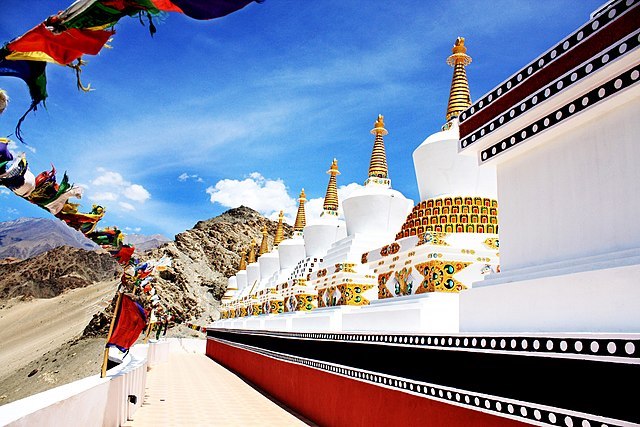
“Just like Pangong lake water, which can neither be drunk nor put to any use, is the office of the lieutenant governor of Ladhak,” is a general comment on every native’s lips in the Ladhak region. The region since it was turned into a union territory after the abrogation of Article 370 had built high hopes of development owing to its direct connection with New Delhi.
However, if nearly three years of the period are taken into consideration, there have been dissensions, resentment brewing at a rapid pace and people fearing that someone else is pulling their strings of development, instead of them, themselves.
Major Issues Worth Noting
The first one is the sheer control of the bureaucracy over the administrative structure which is further controlled by New Delhi and dwarfs the two democratic hill councils of the region. These hill councils are Kargil and Leh. The former is controlled by NC and the latter by BJP.
The respective budgets of these hill councils are nearly Rs 300 crore annually, whereas the UT administration budget is Rs 5,958 crore.
This entire budget is not under democratic control but under a few bureaucrats who are running the show. And as a recent visit of the author to the region and interaction with the local population substantiates the point that there is hardly any interface between the bureaucrats and the people. Neither the elected nor the common people are part of the developmental processes.
It is in this background that this saying emerged in Ladhak about the lieutenant governor of Pangong lake. The LG is approachable but does not perform a bit when it comes to settling the demands of the people.
Land becoming a major issue
The second major issue that has crept in the recent period is the issue of land and particularly “Nau Tuar” land. Nau Taur was practised during the J & K period even before independence. Naur Taur simply means breaking new land, mainly barren and wasteland for cultivation. As the Raja wanted more revenue hence new land and its settlement was allowed in the entire J & K., unlike Himachal Pradesh, where this law was implemented to allocate land to the landless, in J & K it was liberally used by the people to cultivate the land and in a few years’ time through the settlement of land records, Naur Taur land would be mutated in the name of such occupiers of land.
Now in a recent order in April 2022, by the revenue secretary/commissioner of Ladhak union territory, the Nau Taur land has been questioned and if the purpose of the land has changed, say for example from agriculture to commercial, which has happened widely(conversion of land from agriculture to hospitality, etc.), then there is a threat that such land can vest with the State. The office order terms this practice as nefarious. Also, the new mutations of Nau Taur land will be done by the deputy commissioner and not the tehsildar. This is also creating much discontent amongst the local people owing to the long distance that the people might have to travel to get such mutations confirmed.
Tribal Status
The people had high hopes that the entire region will be announced as tribal under Schedule VI of the Indian Constitution. However, the government is yet to take a decision in this regard. It is felt that the union government deliberately wants not to announce this status owing to land rights accruing out of such a status once granted. Take for example harnessing solar power energy from the region. It is estimated that the region has almost 300 days of clear sky and very high photo voltaic strength. This can get converted into solar power energy.
Already big giants in the solar power industry are contemplating harnessing this energy. If the tribal status is guaranteed then the local people become one of the most important stakeholders in the exercise. Minus that, it is just the government to government or a private player that will be material.
Given this background, it is seen that large swathes of land across the road leading from Leh to Kargil find boundaries being drawn along the land with stones etc. On asking what this signifies, the author was told that the local people have started encroaching on the village common land doubting the UT administration, that they would hand it over to outsiders for various reasons.
The disconnect between the people and the UT administration is quite stark.
The Consultant Nexus
The fourth important issue is the perniciousness of this nexus. Eyeing the large share of the UT administration in the region, large consultants in the development sector have already ventured. Big names are part of the PMU (Project Monitoring Unit) and are guiding the UT administration with a complete project-oriented approach instead of a holistic and comprehensive one. No wonder a good share of consultancy is usurped by them, the local level planning in designing their mobility, infrastructure or even industry is hardly seen. The people are completely out of the box and soon these reports would be worthless as they do not evolve from the due process of people’s participation.
Take for example a simple phenomenon of tourism-related development. This year nearly 8 lakh tourists are estimated to visit Leh. This is many times the population of the town(31,000). Almost three times the population of the entire region. How to make tourism sustainable, less polluting, sync with climate change and sustainable development goals are not even being discussed. The blind rush for land use change from agriculture, particularly urban agriculture to hospitality can be a big disaster in the near future. Just to cite one example. Because of this shift already 90 per cent of the water sources have got polluted in Leh town, owing to a non-comprehensive plan for tourism and urban development. The shift from dry toilets to flush is one of the major reasons.
Don’t Abet this Divide
Lastly, the contradiction being deliberately brewed between Shia Muslim populated Kargil and Buddhists populated Leh regions by a certain section of the clergy who are hand in glove with the ruling establishment can have perilous and non-resolving impacts on the people and the regions for too long. The people have stood together and have a common culture and have lived long with fraternal bonds. The exercise of the ruling coterie to build fissures in these regions can be detrimental to everyone. A recent march from Leh to Kargil by one section though put on hold for the moment was planned in this direction.
The regions of Leh and Kargil that are known for their scenic beauty are demanding urgent attention and resolving the issues, pending for a long could be perilous for both its people and the establishment.
Former deputy mayor Shimla.
National convenor, NCU, National Coalition for Inclusive & Sustainable Urbanisation.



